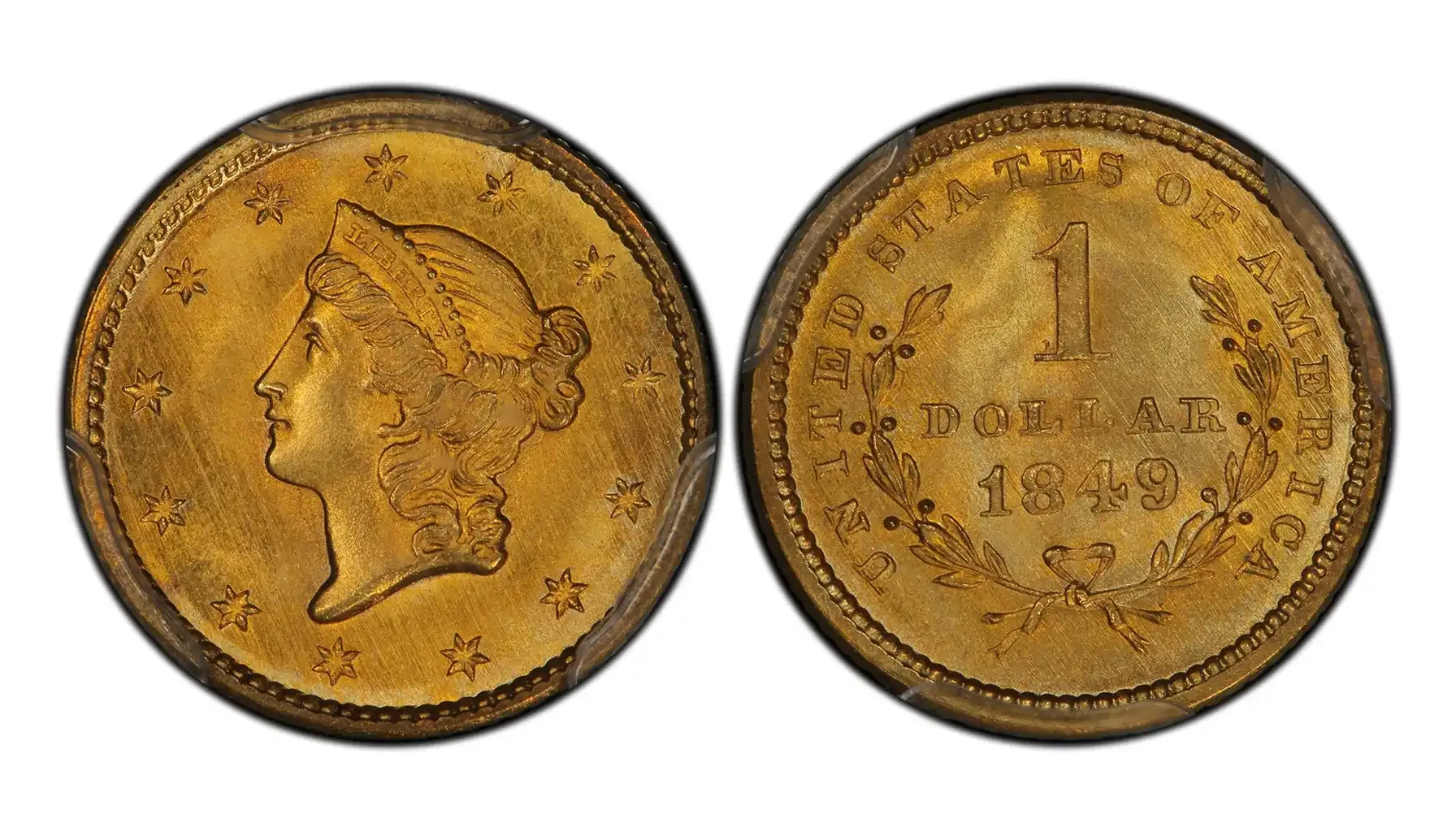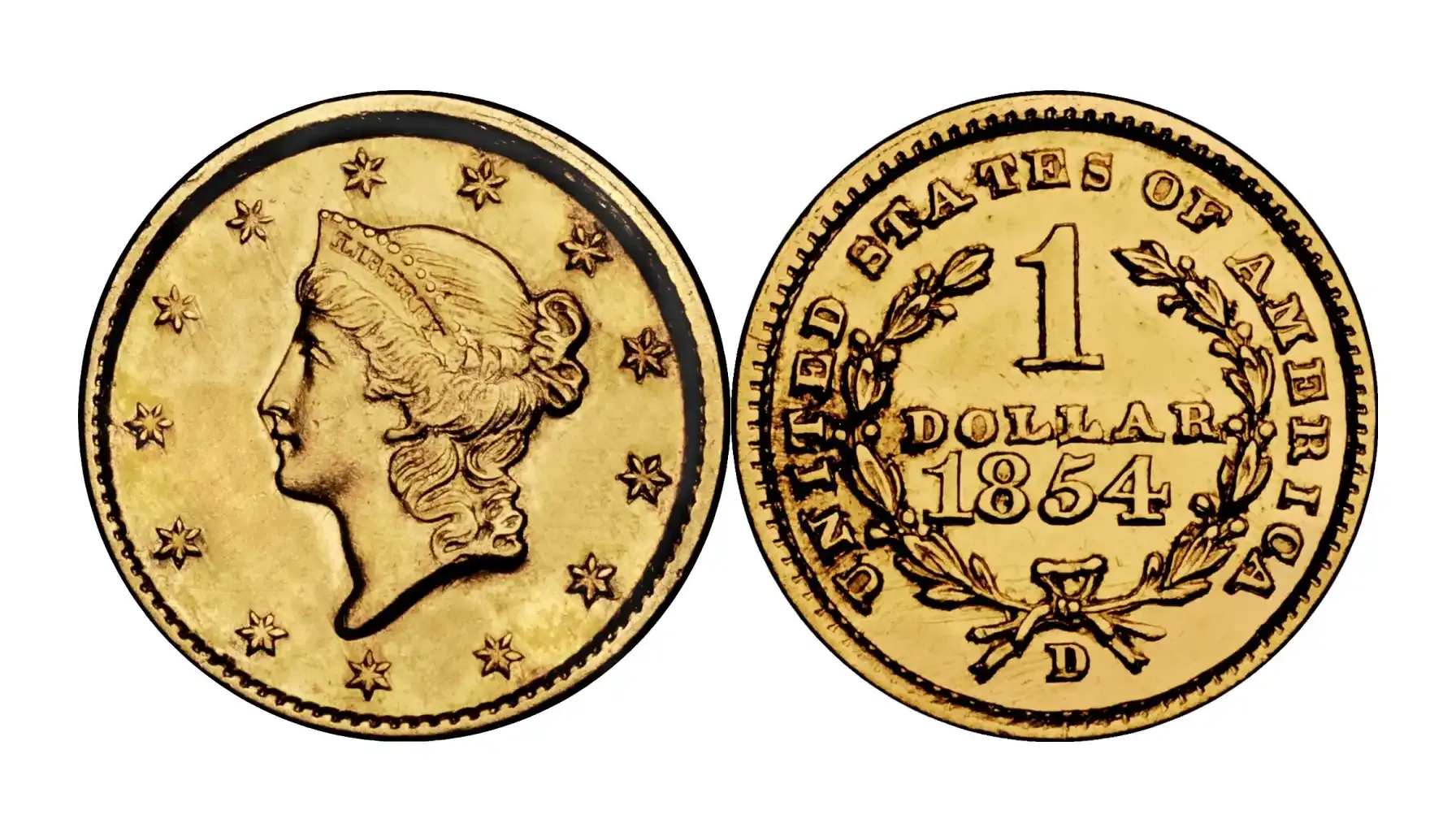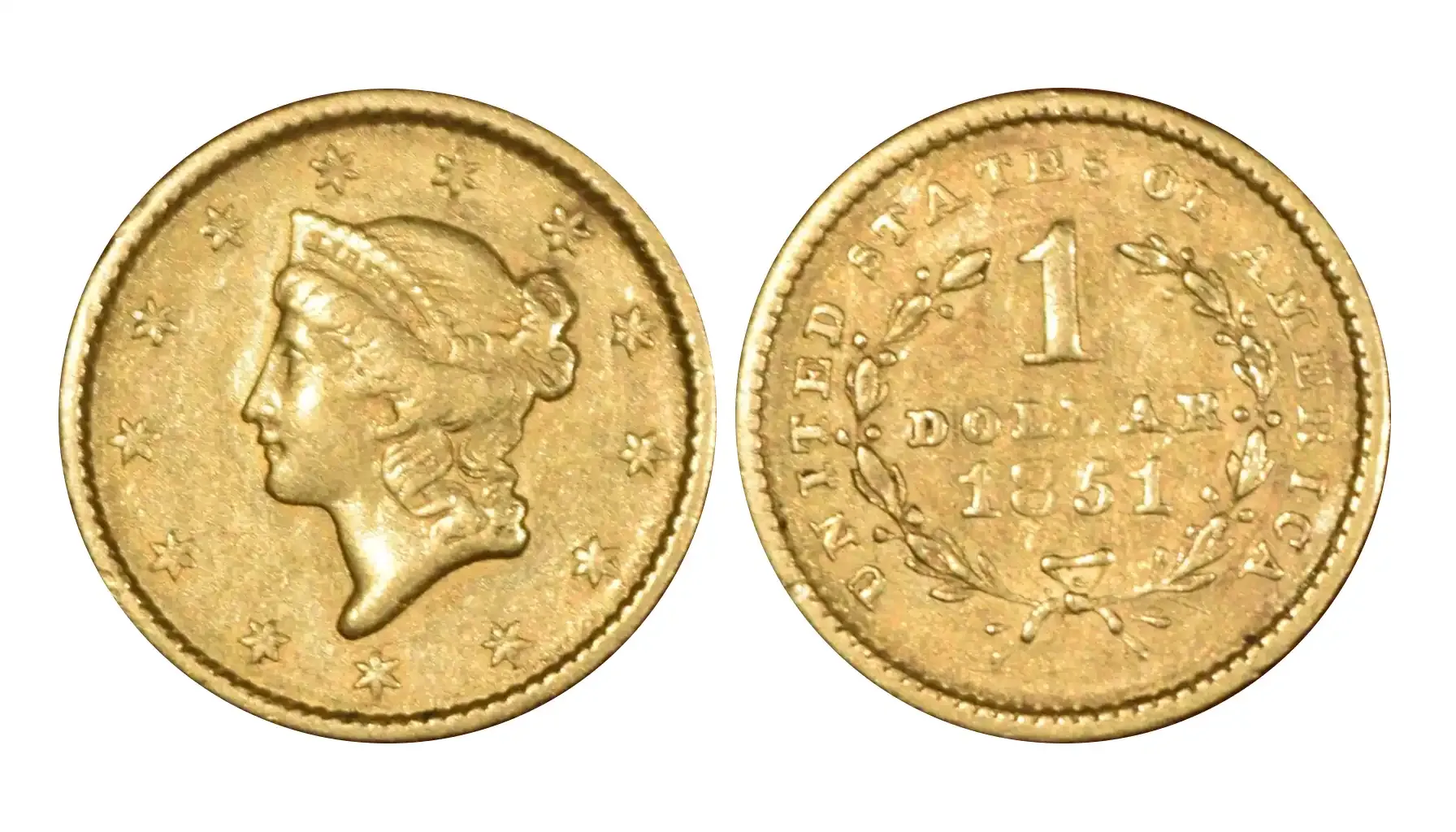Contents:
The Type 1 Gold Dollar debuted in 1849 as the first small-format gold dollar coin struck by the US Mint. Its release came on the heels of the California Gold Rush, when the sudden flood of this precious metal demanded new ways to convert the metal into something stable and worthy.
This series ran from 1849 through 1854 and was characterized by a tiny 13 mm diameter that could set it apart from later issues. As a unique numismatic creation, it is worth studying from the collector’s perspective to decipher the most peculiar features that identify this coin as rare and learn more about the series that was meant to shape a new generation of currency.

Origins and Historical Context
The first US 1 dollar gold coin appeared in 1849 after Congress authorized a small denomination to ease commerce in the California region, but the idea of their appearance was pronounced long before their official release. At first, the Mint hesitated to produce this type of currency, mainly because of its precious content, small size, and the ease of loss.
Nevertheless, the Gold Rush of 1848 changed the map and finally offered an opportunity and necessity for new coin denominations to help absorb the surplus and facilitate commerce. Type 1 emerged as the first official gold dollar ever issued by the US Mint, which might have boasted a simple yet elegant design by Chief Engraver James B. Longacre.
Timeline of Key Minting Years (1849–1854)
1849: The first Liberty Gold Coin 1 dollar struck by the Philadelphia Mint
1850: Continued Philadelphia issues; first branch mint proposals
1851: Production increases amid the California Gold Rush
1852: Small mintages due to supply fluctuations
1853: Restrictions on gold dollar weight and alloy introduced
1854: Final 1854 1 dollar gold coin of Type 1 series produced
Design & Composition Details
The subject of the article is rather peculiar to explore. As such, it was the smallest coin ever struck by the US Mint in both diameter and weight, yet, however diminutive this could feel, the coin was far more immense and significant than its size would suggest. The small format required precise engraving to show Liberty’s coronet and wreath details. Hence, it was the standard for later issues to be incorporated.
The Main Characteristics of Gold 1 Dollar Coins | |
Years of Issue | 1849–1854 |
Designer | James B. Longacre |
Obverse Design | Liberty Head with coronet |
Reverse Design | Wreath encircling denomination & date |
Composition | 90% gold, 10% copper |
Fineness | .900 fine gold |
Gold Content | 0.04837 troy oz (1.504 grams of pure gold) |
Weight | 1.672 grams |
Diameter | 13 mm |
Thickness | ~0.76 mm (varies slightly by strike) |
Edge | Reeded |
Mint Marks | None for Philadelphia “O” for New Orleans “S” for San Francisco “D” for Dahlonega “C” for Charlotte |
How Much is a Gold 1 Dollar Coin Worth?
Collectors gauge the $1 dollar gold coin value by year and condition. Early dates like 1849 and 1850 may indeed command higher prices due to low mintages and their status as “one-of-a-kind”. Auction records demonstrate that those units in mint state often sell for several hundred dollars more than worn examples, reflecting the gold 1 dollar coin value spike for rare dates.
The intrinsic gold content of such creations gives it a base value tied to current gold prices. To estimate this base value, you can use the following formula:
Intrinsic Value = Spot Price of Gold (per troy oz) × 0.04837
For example, should the current spot price be $2,400 per troy ounce (as of July 2025), the intrinsic (melt) value would be:
$2,400 × 0.04837 = $116.09

Factors That Raise or Lower Value
Mintage Rarity: Low‐production years drive higher demand.
Condition Grade: Better surfaces and strike details boost prices.
Mint Location: Branch mint issues can add a premium.
Historical Provenance: Coins with pedigrees or famous collections fetch more.
Surface Quality: Clean fields and sharp devices enhance auction appeal.
Related article: Rare Gold Coins: Spot the Most Valuable Dollar on the Market
Rare Date Highlights
1849: ~1.7 million minted (lowest production)
1850: ~1.8 million minted (early scarcity)
1852: ~1.2 million minted (gold supply changes)
1853: ~1.3 million minted (post-weight adjustment)
1854: ~1.3 million minted (final Type 1 year)
Average Values by Condition
Year | Good (G–4) | Fine (F–12) | Extremely Fine (XF–40) | Mint State (MS–63) | Auction Record (Grade) |
1849 | $150 | $190 | $300 | $650 | $1,560,000 for MS62 |
1850 | $160 | $200 | $320 | $750 | $88,125 for MS68 |
1851 | $155 | $190 | $310 | $700 | $108,000 for MS68+ |
1852 | $160 | $210 | $340 | $850 | $312,000 for MS69 |
1853 | $150 | $200 | $330 | $800 | $264,000 for MS69 |
1854 | $150 | $180 | $280 | $600 | $64,625 for MS64 |
Modern Confusions: Other $1 Gold Coins Compared
For new collectors, it might be a challenge to find a proper coin without confusing it with other units like the popular Sacagawea design. To avoid that mix-up, note that Sacagawea coins bear a golden eagle on the reverse and carry no intrinsic gold weight. Watching marketplace listings for 1 dollar gold coin Sacagawea value reveals that these are modern clad pieces, not solid gold ones.
Others conflate Type 1 dollars with early Liberty issues or rare patterns. The rare Martin Van Buren $1 remains a pattern experiment rather than a circulation strike. Likewise, the classic Liberty Type 1 features Longacre’s coronet design, while later commemoratives show different reverses and edge lettering. Even related issues like the 1914 $2.50 gold piece differ significantly in size and weight, underscoring the importance of careful visual inspection first.
Modern bullion coins also blur the picture for newbies. A 1 oz gold numismatic creation (e.g., 2024 American Eagle Gold Coin) displays heraldic eagles and a matte finish. Its sibling, the 1 oz 50 dollar gold coin, shares similar weight but a proof finish and distinctive mint mark. Neither resembles the small, plain-rimmed Type 1 gold dollars, which measure just 13 mm across.
Key Visual Differences to Spot
Size & Weight: Type 1 dollars measure only 13 mm and weigh 1.672 g. Modern $1 and bullion pieces reach 26–32 mm and weigh 31.1 g.
Color & Finish: Genuine gold dollars show bright yellow relief; Sacagawea and clad dollars display manganese bronze.
Design Elements: Type 1 features Longacre’s Liberty head and wreath. Sacagawea shows Native American themes. Bullion coins carry eagles or commemorative reverses instead.
Edge Details: Type 1 edges are plain with a raised rim. Moderns often use reeded or edge lettering.

Where & How to Sell a 1 Dollar Coin Gold
Should you be willing to buy or sell any coin, it is worth turning to the right venues (e.g., coin auction platforms) and the approach so as to ensure you or other collectors receive fair value. Before listing, determine the condition and rarity to set a realistic price. You should also compare recent sales to gauge current demand. For example, checking the $1 dollar gold coin value 2000 sales helps you understand how market trends affect pricing in progress.
Recent Sale Prices at Major Auctions
Auction House | Sale Date | Coin Date | Grade | Sale Price |
Heritage Auctions | 2024-03-15 | 1849 | MS62 | $780 |
Stack’s Bowers | 2023-11-02 | 1850 | VF30 | $220 |
GreatCollections | 2024-01-10 | 1853 | AU55 | $310 |
Classical Auctions | 2023-08-25 | 1854 | EF40 | $185 |
Legend Rare Coin | 2024-05-05 | 1857 | MS60 | $410 |
Steps for Verifying Authenticity & Selling Safely
Examine the coin with a loupe for correct weight and fineness markings. One is also encouraged to employ digital tools like Coin ID Scanner to learn more about the coin and its background.
Submit to a trusted grading service (PCGS, NGC) for expert authentication and grading.
Research recent auction prices to set a competitive reserve.
Choose a reputable auction house or dealer with buyer guarantees.
Control the shipment procedure and use a tracked, signature-required delivery.
Explore the legacy of coins you own and remember that the true value is in the stories they carry – they will outlast any price and generations far beyond your own.



